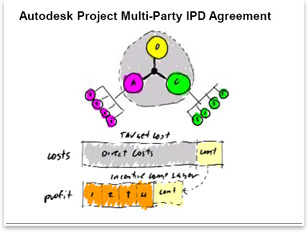| IPD Overcomes the Divergence of Design and Construction
Summary: "The future is already here. It's just not evenly distributed," said Autodesk Vice President Phillip Bernstein, FAIA, July 9 at the Building Museum in Washington, D.C. Quoting science fiction writer William Gibson, Bernstein was explaining the slow-to-take-hold yet impending revolution of integrated project delivery.
 Mulling on the decades-old issue of who is in control in the triad of owner, architect, and contractor, Bernstein concluded that when the project team is motivated to work together with a shared focus on the owner’s outcome goals, “who’s in control becomes irrelevant.” Mulling on the decades-old issue of who is in control in the triad of owner, architect, and contractor, Bernstein concluded that when the project team is motivated to work together with a shared focus on the owner’s outcome goals, “who’s in control becomes irrelevant.”
Bernstein’s evening presentation “Get Back to Where You Once Belonged: The Perils and Opportunities of IPD Dissected” was a part of the Microdesk “Building Success” series of lectures.
For so many years, the separation of design from construction has been ingrained in the psyche of the profession, noted Bernstein, who also lectures on professional practice at Yale, serves on the AIA Contract Documents Committee, and is the author of the “Project Delivery Methods” chapter in The Architect’s Handbook of Professional Practice 14th Edition. That separation between design and construction, so seamless in the building of the pyramids began with the establishment of guilds in the 15th century, widening further and further through the Industrial Age until now, when information technology promises a remerging—but not without a change in deeply ingrained predispositions among all parties involved (and their legal counsel).
Even with his own experience of working as the owner representative on two ongoing IPD projects, Bernstein said he still falls into a contractor-versus-architect mindset from time to time. Therefore, he advised, the first step toward adoption of IPD as a project delivery approach is transformational as the architect and contractor accept each other as equals with one shared goal: meeting the client’s preferred outcomes.
 Practice what you preach Practice what you preach
For two office retrofit projects currently under way—one on the East Coast and one on the West—Autodesk, whose building information modeling software Revit is a major player in the 3D BIM arena, committed to using IPD. They were determined to walk the walk, Bernstein said.
Some aspects that set IPD apart from most of its predecessor delivery approaches is the three-party contractual sharing of risk and reward in achieving the client’s goals. For instance, one important goal in the Autodesk projects was to have team buy-in to IDP in the first place, which played a big part in team selection. Achieving that goal was immediate. Another goal for the two projects is to achieve LEED® Platinum. Determination of whether that goal is reached will have to wait until the requisite number of LEED points has been accrued, possibly after construction is complete. And there is a range of outcome goals in between, all negotiated and contractually set at the outset, Bernstein said.
The contract agreement crafted specifically for these projects set a target budget that includes the estimated cost of the construction plus profit payments tagged to each of these specific outcomes. If the project comes in under the target budget in the Autodesk project contracts, Bernstein said, the client keeps 60 percent and the architect and contractor split the remainder. If the project goes over budget, Autodesk still pays for completion, but, Bernstein said, “I get fired.” Clearly, all parties are committed to the success of the project.
Beyond the mutual agreement that separates cost from profit, the three parties agree that they will not bring suit against the other parties. The anticipated result is that the team focuses on working together to achieve specific outcomes as the project moves from concept to occupancy. Even in the face of some serious project team disagreements, the IPD contracts have both worked, Bernstein reported.
 A virtual building prototype A virtual building prototype
Making the reconnection of design to construction possible are the many recent advances in digital coordination technologies, including interoperable software applications and super-fast computer and communications platforms.
Buildings heretofore have been permanent prototypes with little opportunity for full-scale testing over time. Now, with 3D building integration modeling software and the many crash-check and performance applications for testing the building model, quality control—including a range of building performance analyses—is possible at every step of design development.
For the designer, the break-through challenge is to create buildable construction documents. As an example, Bernstein described the Kieran Timberlake Loblolly House, which consisted of prefabricated modules. And, instead of measured drawings, the architect’s documentation was more in the form of assembly instructions.
In turn, what the contractor finds an initial challenge in IPD is trying to create a schedule for the architect’s design process.
The reward is higher profitability, tighter quality control, and a delivery approach that rewards cooperation rather than conflict. The days of the architect delivering instruments of service that “dare the contractor to build from them” are over, Bernstein said. “It’s not a healthy construct.”
And to those reluctant to take the leap he added a sobering anecdote, having recently returned from China where he witnessed the graduation of a thousand MArch candidates and 500 doctoral candidates. Competition is truly global, and in a decade those newly minted architects, who are eagerly embracing new technologies and the project-delivery breakthroughs they are enabling, will be competing directly in Asia, Europe, and the U.S., Bernstein warned. Be prepared. |



